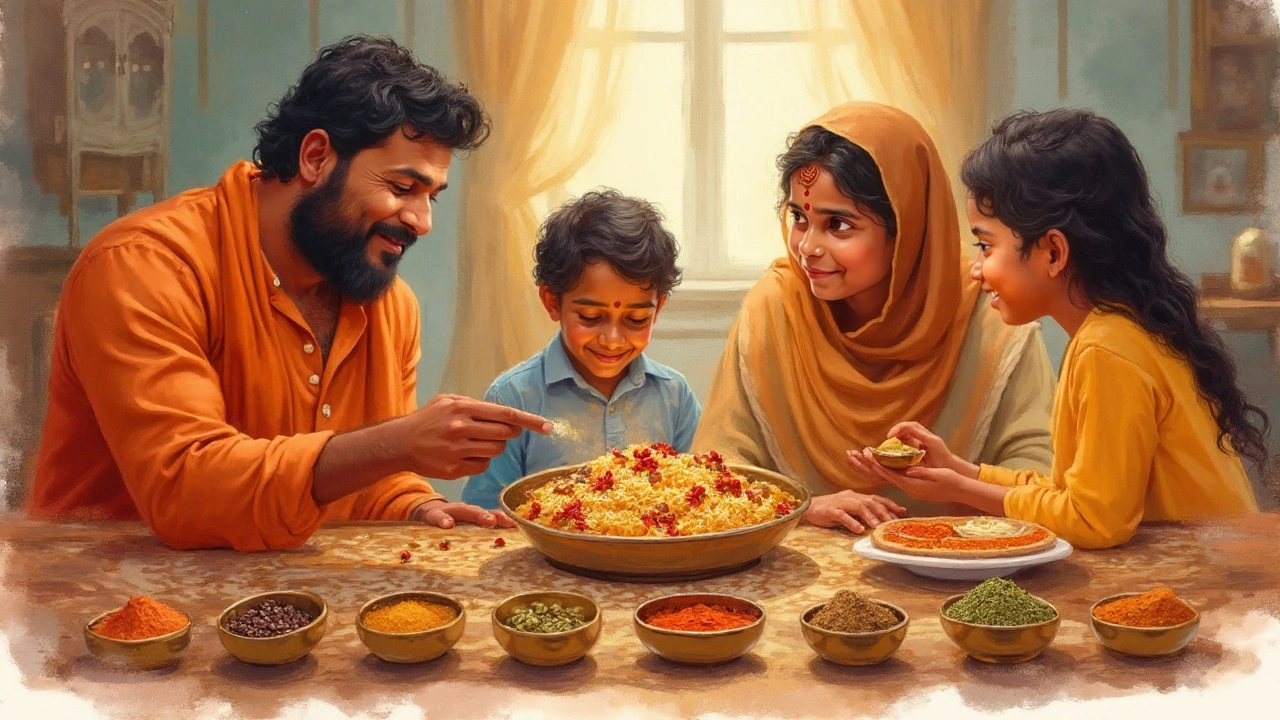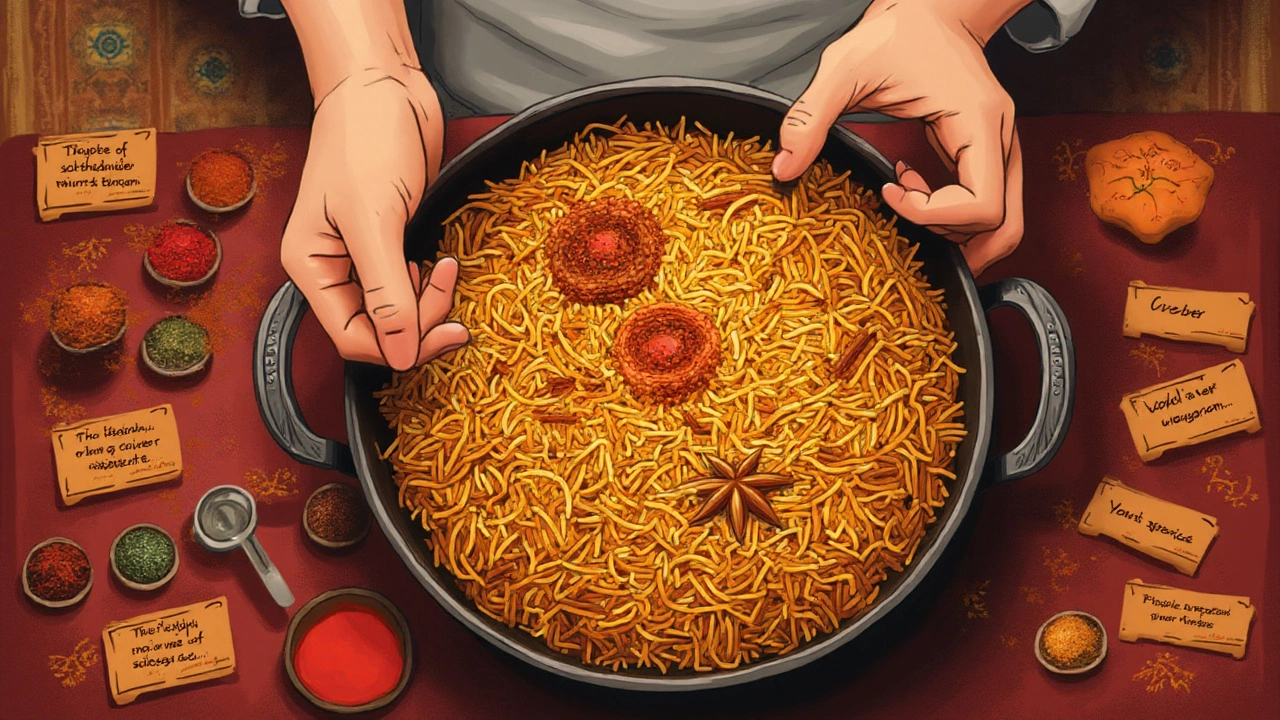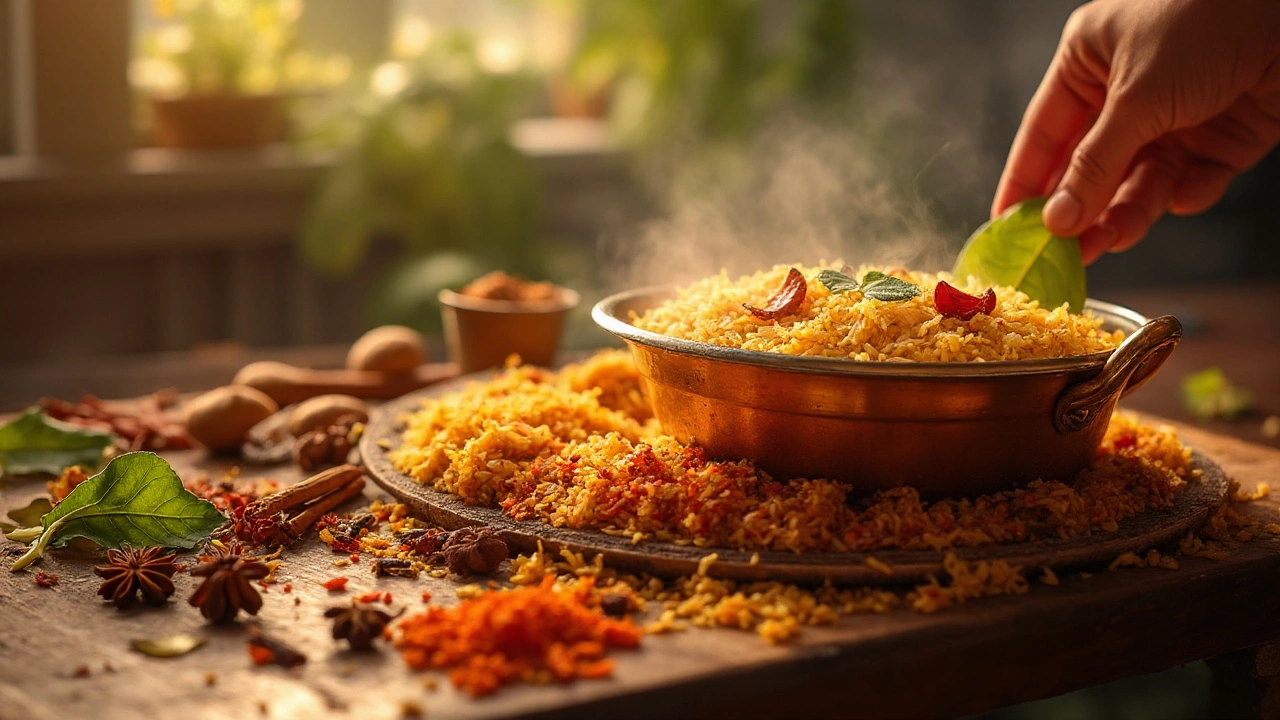Ever found yourself pausing mid-bite, picking out mysterious black bits from your biryani, and asking, 'What is THIS?' You're definitely not alone. Even die-hard biryani fans get stumped by these aromatic little pieces. They're small, sometimes poky, and can come as a surprise if you crunch down on one unexpectedly. But here’s the thing—without those black bits, that signature biryani aroma and taste just wouldn't exist. Let’s rip into the secrets behind these tiny spicy surprises, decode what they are, and learn why you probably shouldn’t toss them away.
The Mystery Black Things: Naming Each Culprit
Right, let’s set the record straight. When people complain about 'black things' in biryani, they usually mean whole spices tossed in during the cooking process. These aren’t “leftovers” or random debris—cooks actually put them there on purpose. Here’s a quick rundown of the suspects you’ll most often find:
- Black Cardamom – Large, wrinkled pods with a smoky, robust aroma. Usually darker than green cardamom, almost blackish brown.
- Cloves – Tiny, nail-shaped, deep brown to nearly black dried flower buds with an intense, spicy bite.
- Black Peppercorns – Small, round, jet-black balls whose flavor sneaks up on you with a little heat.
- Cinnamon bark (or Cassia) – Shards of dark brown to blackish wood, packed with warmth and sweetness.
- Star Anise – Eight-pointed, star-shaped, brownish-black spice pods, sometimes whole or in pieces.
- Bay Leaves – Though not black, these can sometimes turn dark and papery in cooked biryani and can be confused among other bits.
- Mace, Cumin Seeds, Dried Chili – Again, sometimes added for depth, but less often the 'black things' people notice.
Different biryani recipes and regions have their own favorite spice combos, but you’ll spot these core black bits across most plates—Hyderabadi, Lucknowi, and even Kolkata biryanis.
Why Are These Spices Added? (And Why Don’t We Just Powder Everything?)
If you’ve ever tried blindly chewing a whole clove or cardamom pod, you may wonder why on earth anyone would put these solid spices in food, especially when ground powders are handy. The answer: flavor release. Whole spices cook differently than powdered ones. When added whole, these spices infuse rice and meat with a slow, deep, fragrant aroma without turning your biryani muddy or too spicy hot.
Grinding everything into a powder can make the dish straight-up overwhelming or gritty. With whole spices, you get a gentle perfume and pockets of flavor, not an even, dull blast. Also, some spices—like star anise and black cardamom—taste bitter or weirdly strong if ground and left to stew. Keeping them whole allows cooks to control how much flavor gets into the rice and pick them out before serving, if they want.
Fun fact: A recent survey by the Rice Association of India reported that 82% of biryani chefs in Hyderabad still use whole spices as their main flavoring, even with modern grinders available. There’s just something magical about that classic method.

Spotlight on the Main Black Spices: What They Bring to Biryani
Let’s break down what each of the black things brings to your plate besides confusion and occasional spicy surprises.
- Black Cardamom: Smoky, robust, almost camphor-like. Black cardamom isn’t sweet like its green cousin; it works its way into every grain, giving a warm, rustic backbone, especially in meat biryanis. Tip: Fisher them out before eating, as biting into one is like biting into strong potpourri.
- Cloves: Tiny but mighty. Just a few can knock your socks off in terms of fragrance. They provide heat, sweetness, and a punch for your taste buds. Some people love the surprise crunch; most spit them out after one bite.
- Black Peppercorns: When you want a little burst of heat, peppercorns do the job. They seep subtle spice throughout the dish but don’t dominate. Plus, they have antibacterial perks and can aid in digestion—though only if you’re brave enough to chew them.
- Cinnamon Bark: These sticks look tough, but they unravel into delicate, sweet-spicy layers in hot rice. Cinnamon ties together the floral and earthy notes, and adds an inviting aroma that screams 'biryani' even before you lift the lid.
- Star Anise: More common in Kolkata and some modern biryanis, star anise gives a licorice edge and lifts the whole blend with its floral perfume.
Here’s a quick way to imagine what each does in your biryani:
| Spice | Flavor Profile | Main Benefit | Pro Tip |
|---|---|---|---|
| Black Cardamom | Smoky, earthy, bold | Deep background flavor | Remove before eating |
| Clove | Warm, spicy, sweet | Instant aroma boost | Count the number used, so you don’t choke on them |
| Black Peppercorn | Spicy, sharp | Mild heat, health perks | Crush a couple for extra flavor |
| Cinnamon | Sweet, woody | Balances other spices | Use sticks, not powder |
| Star Anise | Floral, licorice | Lifts fragrance | Add near the end of cooking |
Health Perks and Practical Tips for Dealing with Whole Spices
Yes, the black things in biryani do more than just flavor up your food. Most whole spices have legit health benefits. Black cardamom is linked to helping with respiratory issues. Cloves are loaded with antioxidants and are old-school fixes for toothaches. Pepper is famous for boosting digestion and even making the nutrients in food more available for your body. Star anise is rumored to have anti-bacterial powers. Pretty cool, right?
If you find whole spices annoying or just want to make life easier for your guests, here are a few tricks:
- Tie the spices in a small ('muslin') cloth before adding to your rice, then remove the bundle when cooking’s done. This way, you get the flavor but none of the bites.
- Count how many cloves or cardamoms you toss in, and make sure to fish them out right before serving—especially if you’re feeding kids.
- Tell guests what to expect. If you’re serving biryani, a casual heads-up like, "Hey, don’t be surprised by the whole spices!" can save someone from an awkward crunch.
- If you like strong flavor but less drama, roughly crack peppercorns and cloves with the flat of your knife to release their aroma, but make them easy to spot and pick out later.
But seriously, don’t ditch the whole spices—they do way more than just play hide-and-seek in your rice. Fake biryanis made solely with biryani masala powder or ground spices just don’t cut it. There’s a freshness only real whole biryani spices can offer.

How Culture and Tradition Shape the Spices in Your Biryani
This might surprise you—each region has its own favorite mix of black bits. In Hyderabad, you’ll nearly always spot huge black cardamoms and a heavy hand with cloves. Lucknowis love a more subtle, earthy mix with less star anise and more cinnamon. Kolkata biryani, famous for its gentler, less fiery flavors, often throws in a bay leaf and the occasional star anise but goes easy on the cardamom. South Indian biryanis sometimes even feature curry leaves, which aren’t black but get mistaken for 'mysterious' by people used to North Indian styles.
Some home cooks swear by roasting whole spices first, others just toss them straight into the pot. Cooking biryani over a dum (sealed pot over charcoal or slow flame) allows these spices to fully bloom, infusing rice with an aroma that can literally make neighbors jealous. In some families, uncles and aunties will argue over the exact spice combo every Eid or wedding—probably why no two biryanis ever taste exactly the same.
And, a wild fact: In India, the word 'garam masala' (hot spice blend) means something totally different depending on where you are. Some garam masala powders are made almost entirely of these 'black things' ground up, but true biryani aficionados always prefer them whole in the cooking process to keep the aroma alive and the experience, well, authentic.
So next time you spot one of those black bits in your biryani, think twice before tossing it to the side of your plate, or worse, complaining. They’ve traveled generations, crossed borders, and made it through family feuds—all to end up in your perfect plate of biryani.
